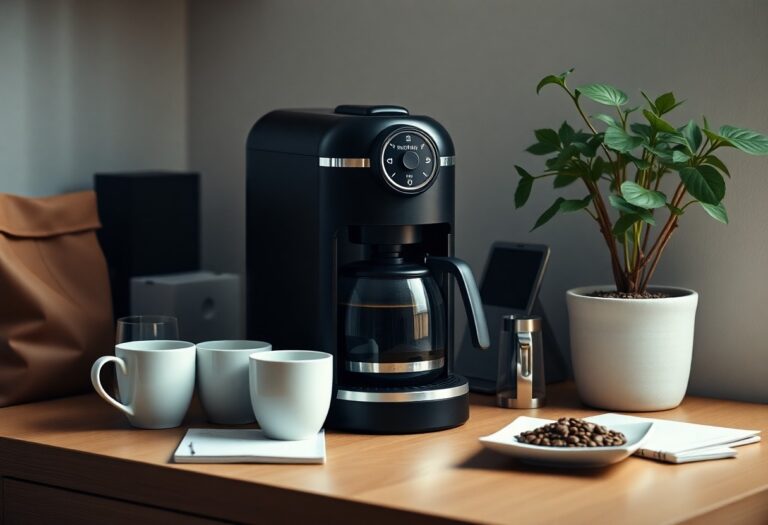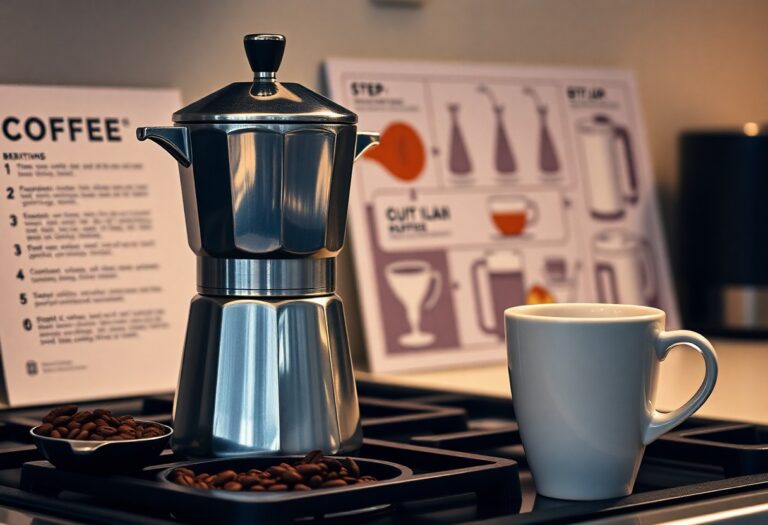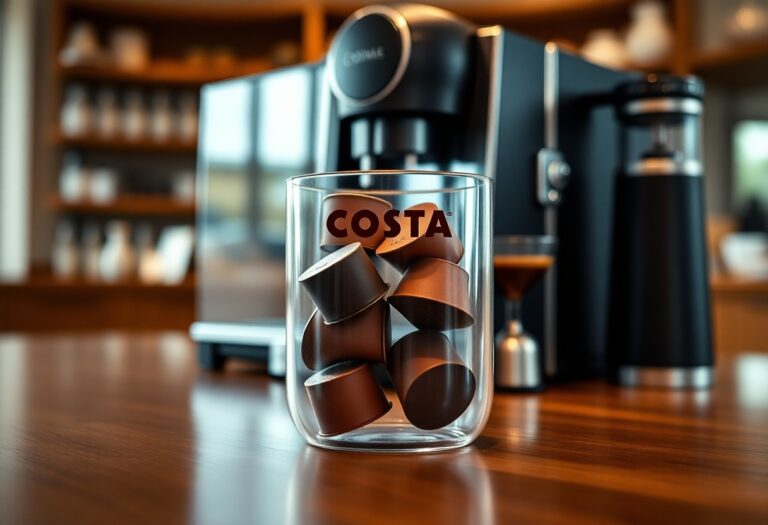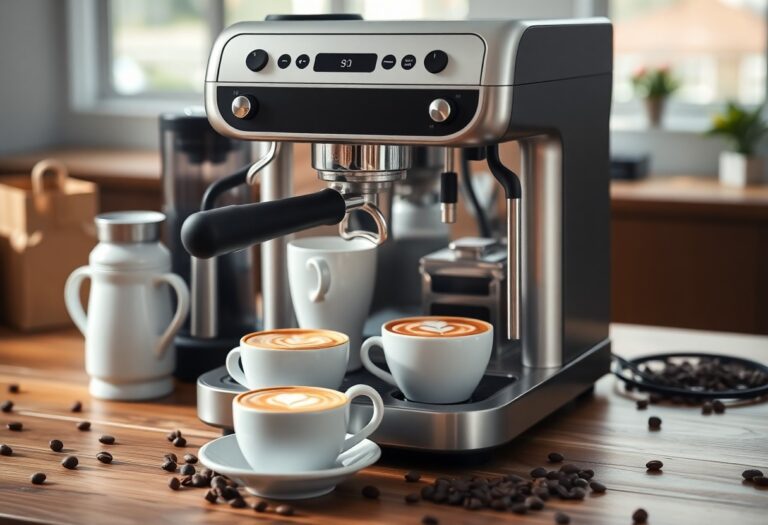What is a Pump Coffee Machine – Pressure System
You might be wondering what differentiates a pump coffee machine from other brewing devices. These machines utilize a pressure system to extract rich, flavorful coffee from finely ground beans, giving you that café-quality shot right at home. By generating the necessary pressure, typically between 9 to 15 bars, pump coffee machines significantly enhance the coffee’s aroma and body. Understanding how these systems work can help you appreciate the art of coffee making and elevate your brewing experience.

Key Takeaways:
- A pump coffee machine uses a pressure system to brew coffee, providing consistent and high-quality extraction of flavors from coffee grounds.
- Pressure typically ranges from 9 to 15 bars, allowing water to flow through coffee at the optimal rate for better quality espresso and coffee concentration.
- The pump design enables quick heating of water and ensures that the brewing temperature remains stable throughout the process.
- These machines often include features like programmable settings, steam wands for frothing milk, and built-in grinders, enhancing the versatility of coffee preparation.
- Regular maintenance, including descaling and cleaning, is necessary to keep the pump coffee machine functioning efficiently and to prolong its lifespan.

The Mechanics of Pressure: How Pump Coffee Machines Work
Understanding the mechanics behind pump coffee machines reveals their reliance on a pressurized system that forces hot water through finely-ground coffee. This process extracts vital oils, flavors, and aromas, resulting in a rich espresso shot. Inside these machines, a pump pressurizes the water, which is then heated before being sent to brew your coffee. If you want to know more about the distinctions between various systems, check out what is the difference between a pump and steam pressure system.
The Role of Pressure in Coffee Extraction
Pressure serves a fundamental role in the extraction process, where water at elevated pressure permeates through coffee grounds. Ideal brewing pressure ranges from 9 to 10 bars, which helps dissolve oils and extracts complex flavors from the coffee. The right amount of pressure not only ensures that you achieve a balanced flavor profile but also contributes to a beautiful crema—a sign of a well-extracted espresso.
Components that Create the Perfect Brew
Crafting the perfect cup of coffee requires various components working seamlessly together. The pump, heating element, water reservoir, and filter basket are vital for creating that coveted espresso experience. Each component plays a unique role in the process, from the pump generating pressure to the heating element ensuring your water reaches the ideal temperature.
Your brewing equipment’s components are not just parts; they are integral to the entire coffee-making experience. The pump generates the necessary pressure for extraction, while the heating element heats water to the required temperature—typically between 195°F and 205°F. A single or double filter basket holds the coffee grounds, ensuring even extraction. Together, they create not only the flavor but also the aroma and texture you crave. Understanding these components will enhance your barista skills and elevate your coffee enjoyment.
The Art of Crafting Espresso: Pressure and Flavor
Delving into the intricacies of espresso preparation, you’ll find that pressure plays a vital role in extracting rich flavors and aromas. The right amount of pressure allows water to flow through the coffee grounds, ensuring an optimal extraction time. This precision brings about a balance of acidity and sweetness, culminating in a deliciously crafted shot of espresso. Mastering this art emphasizes the synergy between your technique and the equipment at your disposal.
The Influence of Pressure on Flavor Profiles
Pressure significantly impacts flavor profiles by determining the rate at which water extracts oils and soluble compounds from coffee grounds. At around 9 bars of pressure, you achieve a sweet spot where the flavors blossom, showcasing the intricate notes within the beans. Variations in pressure can lead to a broad spectrum of tastes—from under-extraction, which might yield sour or weak flavors, to over-extraction, leading to bitterness and harshness.
Comparing Pump Machines and Other Brewing Methods
In comparison to other brewing methods, pump machines stand out due to their ability to maintain consistent pressure levels, vital for achieving a rich and complex espresso. For instance, methods like pour-over or French press rely more on gravity and steeping time, potentially yielding less pronounced flavors. Pump machines enable repeatable results, ensuring each cup is crafted with precision.
Method Comparison
| Brew Method | Pressure Usage |
|---|---|
| Pump Coffee Machine | 9 bars, consistent and controlled |
| Pour-Over | No pressure, relies on gravity |
| French Press | Some pressure upon pressing, but less consistent |
| Espresso Machine (Non-pump) | Varies widely, less control over pressure |
The comparison illustrates that while other methods can produce excellent coffee, pump machines excel in creating espresso with depth and richness. A pump coffee machine achieves a level of pressure that translates into optimal extraction, while brew methods such as pour-over may yield limited flavor development. This is why many espresso aficionados swear by pump machines for a consistently exceptional coffee experience.
The Evolution of Pump Coffee Machines
The journey of pump coffee machines has significantly transformed the coffee brewing landscape. Early espresso machines relied on manual techniques and steam pressure, while modern devices boast advanced pressure systems that enhance flavor extraction. This evolution aligns with consumer demands for consistency and quality, leading to innovations like adjustable pressure settings, which you can explore further in this discussion about what is a pump pressure bar? From 19 to 15 makes a huge ….
Historical Development of Pressure Brewing Technology
Early pressure brewing technology started in the late 19th century, with inventions like the piston-driven espresso machine appearing in Italy. These models faced limitations in pressure consistency, often making it difficult to achieve the perfect shot. Over time, advancements in materials and engineering led to the standardization of pressure around 9 bars, revolutionizing how coffee was extracted and significantly improving taste and quality in every cup.
Modern Innovations and Smart Features
Today’s pump coffee machines are equipped with smart features that enhance user experience and coffee quality. Many models now include programmable settings that allow you to customize brew time, temperature, and even maintain latte art consistency. Connectivity options let you operate your machine via smartphone apps, optimizing convenience and efficiency in your coffee-making routine.
Advanced temperature control systems are another hallmark of modern machines, enabling you to experiment with various brewing techniques to uncover unique flavor profiles. Some machines come with integrated grinders that ensure freshly ground beans are used for each brew, offering superior taste compared to pre-ground options. Moreover, features such as automatic self-cleaning and milk frothing systems cater to your preferences while minimizing maintenance hassles. These advancements not only streamline the coffee-making process but also empower you to elevate your home brewing game to a new level of sophistication.
Choosing the Right Pump Coffee Machine for Your Needs
Selecting the right pump coffee machine is important for achieving your desired brew quality and convenience in your daily routine. Consider your coffee preferences, brewing style, and available space. Additionally, determine how often you’ll use the machine to find the ideal blend of performance and features that suits your lifestyle.
Key Features to Consider Before Purchase
Several key features can enhance your brewing experience and should guide your decision-making process.
- Pressure System: Look for machines with consistent pressure to achieve optimal extraction.
- Temperature Stability: Ensure stable heating elements for the best flavor profiles.
- Grinder Quality: Built-in grinders offer fresh grounds, enhancing the taste.
- Ease of Use: User-friendly interfaces can streamline your coffee-making process.
- Cleaning Features: Automatic cleaning cycles save time and ensure longevity.
Thou should weigh each feature’s importance based on your preferences to make a well-informed selection.
Budgeting for Quality: Cost vs. Performance
Investing in a quality pump coffee machine often offers significant returns in taste and performance. High-end models generally provide better temperature controls and pressure consistency, resulting in superior coffee. While entry-level machines can meet basic needs, they may lack longevity and finesse, leading you to spend more over time on replacements or upgrades. Balancing your financial limits with your coffee aspirations is key, as the right machine can elevate your brewing ritual to new heights.
Maintenance and Care: Ensuring Longevity
Taking proper care of your pump coffee machine is necessary for maximizing its performance and lifespan. Regular cleaning and maintenance prevent the build-up of coffee oils and scale, ensuring that every cup of coffee you brew is flavorful and consistent. Additionally, following the manufacturer’s guidelines on service intervals and using quality water can help maintain your machine in optimal condition.
Essential Maintenance Practices for Peak Performance
To keep your pump coffee machine operating at its best, focus on tasks such as descaling the machine regularly, cleaning the brew group, and ensuring the water reservoir is free of sediment. Use filtered water to reduce mineral deposits and run a cleaning cycle as recommended. Regularly checking seals and gaskets will also help avoid leaks and maintain peak efficiency.
Troubleshooting Common Issues
Occasional issues may arise with your pump coffee machine, from inconsistent pressure to strange noises during operation. Identifying these problems early is key to preventing further damage. For example, if you notice low pressure, check for clogs in the group head or ensure that the pump is functioning properly. Utilizing the troubleshooting guides provided by the manufacturer can also assist you in diagnosing and resolving specific problems.
Common problems can often be addressed with simple solutions. For instance, low pressure could stem from a blocked filter or insufficient grind size, which affects the water flow. A noisy machine might signal air trapped in the water line, which could be remedied by running the pump while emptying the water reservoir. Regular inspection of components such as the pump and portafilter will help you detect any wear or malfunction before they escalate into major issues.
To wrap up
Drawing together the necessary elements of a pump coffee machine’s pressure system, you understand that this technology is pivotal for achieving rich, flavorful espresso. By utilizing pressurized water to extract the coffee’s oils and aromas, you enhance your brewing experience significantly. With the right maintenance and knowledge of how your machine operates, you can consistently enjoy high-quality coffee that meets your taste preferences. Investing in a pump coffee machine not only elevates your coffee routine but also allows you to explore the art of espresso making in the comfort of your home.
FAQ
Q: What is a pump coffee machine?
A: A pump coffee machine is a type of espresso maker that uses a pump to generate the pressure needed to brew coffee. Unlike manual machines that rely on gravity or lever-action, pump machines create consistent pressure, which is vital for extracting rich flavors and oils from coffee grounds. This method allows for a more refined and professional espresso experience.
Q: How does the pressure system in a pump coffee machine work?
A: The pressure system in a pump coffee machine typically uses an electric pump that can generate up to 9 bars of pressure, which is the ideal level for brewing espresso. Water is heated in a boiler and then pushed through the coffee grounds at high pressure, allowing for a quick extraction process. This system ensures that the water interacts with the coffee evenly, resulting in a balanced and flavorful brew.
Q: What are the advantages of using a pump coffee machine over other types?
A: Pump coffee machines offer several advantages compared to other types, such as drip or stovetop coffee makers. The main benefits include consistent temperature and pressure control, which leads to better extraction of coffee oils and flavors. Additionally, they often come with features like steam wands for frothing milk, making them versatile for preparing various coffee beverages such as lattes and cappuccinos.
Q: What maintenance is required for a pump coffee machine?
A: Regular maintenance for a pump coffee machine includes descaling to prevent mineral buildup, cleaning the group head and portafilter to remove coffee oils, and replacing water filters if applicable. It is also recommended to empty the drip tray and directly clean any steam wands after use to maintain hygiene and performance. Following the manufacturer’s guidelines for maintenance can extend the lifespan of the machine.
Q: Are pump coffee machines suitable for home use?
A: Yes, many pump coffee machines are designed specifically for home use and range from compact models to more advanced options. When opting for a pump coffee machine for home, consider factors such as size, ease of use, and features like programmable settings or milk frothers. They can be a great investment for coffee enthusiasts who want to replicate café-quality beverages at home.







